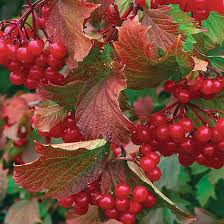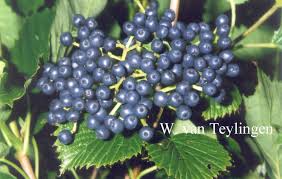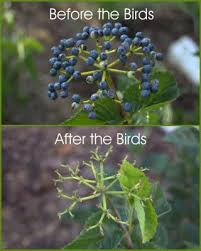
Hi everyone!
Sorry that I am just now writing about the wonderful and vivacious viburnums, but everyone here at Winterberry Farm has been under the weather! All of a sudden, everyone was sniffling and sneezing all over the place! Things have calmed down and I am back to writing about some of my favorite plants!
The Vivacious Viburnums!
These wonderful plants should be in everyone's yard! There are several native viburnums and some exotic viburnums that can be found in nurseries all over the country. Most of the Asian viburnums are known for their spicy scents and over the top large snowball-like flowers, while our native viburnums are drought tolerant, survive well in hostile urban environments, have wonderful fall color and huge amounts of colorful berries to feed our birds and other wildlife during the winter months. Do you think I may be partial to the native viburnums? These vivacious beauties come in many leaf shapes, overall sizes and berry color! Yes - berry color! Berries of the native viburnums range in color from a pink-red all the way to almost a black color with some of the shrubs bearing an intense blue berry! All native viburnums can take wet areas in your yard and most of them prefer wet areas as opposed to dry spots. From what I have observed in my gardens - wet and sunny are the two preferences for most of our native viburnums.
My favorite native viburnum is a tree-form viburnum called the Black-haw or cherry leaf viburnum (Viburnum prunifolium - zones 3-9). Black-haw viburnums are true to one of their common names and have leaves shaped like cherry leaves.
 This shrub can naturalize in wet or dry conditions, in the sun or shade and will grow to over 12' tall with an even wider stance depending on location. This is a great shrub for an area where you can give it plenty of room to spread out and will develop into a great screening plant for three seasons of the year. Birds will nest in its numerous branches and other wildlife will find shelter under its wide canopy.
This shrub can naturalize in wet or dry conditions, in the sun or shade and will grow to over 12' tall with an even wider stance depending on location. This is a great shrub for an area where you can give it plenty of room to spread out and will develop into a great screening plant for three seasons of the year. Birds will nest in its numerous branches and other wildlife will find shelter under its wide canopy.  One thing it doesn't like is a high salt condition so don't plant these babies at the beach! The leaf stems are a bright red color and its dark blue fruits can be made into jelly! That is, if you can get to them before the birds or other animals denude the stems! In the late fall, the red coloration of the leaves and the blue berries make a wonderful statement in your garden. Make sure that you plant this shrub close enough to the house so you can run out and get some of the berries for yourself before they are gone!
One thing it doesn't like is a high salt condition so don't plant these babies at the beach! The leaf stems are a bright red color and its dark blue fruits can be made into jelly! That is, if you can get to them before the birds or other animals denude the stems! In the late fall, the red coloration of the leaves and the blue berries make a wonderful statement in your garden. Make sure that you plant this shrub close enough to the house so you can run out and get some of the berries for yourself before they are gone!Another great native viburnum is Viburnum trilobum (zones 3-9)or the American Cranberry Bush. As the common name states, this viburnum has bright red cranberry-like berries in the fall. The berries of the American Cranberry Bush are also edible and will make a good jelly. But be careful! This shrub is a favorite of our American song birds and they will be watching and waiting for the berries to ripen! I don't know about you but I don't want to get in the way of a hungry song bird!
 These shrubs make a good screen for your backyard and their fall color is a beautiful deep rich burgundy color. Viburnum trilobum is named after the shape of its leaves which have three (tri) lobes at the end of each leaf.
These shrubs make a good screen for your backyard and their fall color is a beautiful deep rich burgundy color. Viburnum trilobum is named after the shape of its leaves which have three (tri) lobes at the end of each leaf.  This shrub can also grow to 15' but low growing cultivars have been developed that will make good low hedges. One very nice low growing (or dwarf) cultivar is 'Compactum Alfredo' and V. trilobum 'Phillips' is a dwarf cultivar that was developed for its flavorful berries. The American Cranberry Bush is supposed to be native to zones 8 and 9 but does not do as well in these warmer climates as it does in the northern sections of its natural habitat. If you live in these zones, make sure to grow these shrubs in a shady area with lots of natural water in the areas that you plant it.
This shrub can also grow to 15' but low growing cultivars have been developed that will make good low hedges. One very nice low growing (or dwarf) cultivar is 'Compactum Alfredo' and V. trilobum 'Phillips' is a dwarf cultivar that was developed for its flavorful berries. The American Cranberry Bush is supposed to be native to zones 8 and 9 but does not do as well in these warmer climates as it does in the northern sections of its natural habitat. If you live in these zones, make sure to grow these shrubs in a shady area with lots of natural water in the areas that you plant it.Viburnum acerifolium, the maple-leaf viburnum is the third of the tree-form native viburnums. Viburnum acerifolium grows only 3-4' in height and approximately 4' wide. This viburnum would be great as part of a shrub border and much easier to control than its larger cousins. It has a wonderful open canopy and gives dappled shade to plants planted beneath it in the border.
 It can tolerate dry shade and turns a 'pink' color in the fall. This viburnum is the larval food for the spring azure butterfly and skippers drink its nectar.
It can tolerate dry shade and turns a 'pink' color in the fall. This viburnum is the larval food for the spring azure butterfly and skippers drink its nectar.  The gorgeous black fruits are a delicacy to native song birds and the branches will be full of birds gobbling up as many of the delicious berries as they can until the branches are stripped bare! All viburnums can be grown as shrubs but these three are the easiest to grow in tree form. To do this, as the shrub begins to grow, cut off the bottom branches of the multiple stems to develop a tree shape. The bark of these particular viburnums have great character and will make a great statement as they mature.
The gorgeous black fruits are a delicacy to native song birds and the branches will be full of birds gobbling up as many of the delicious berries as they can until the branches are stripped bare! All viburnums can be grown as shrubs but these three are the easiest to grow in tree form. To do this, as the shrub begins to grow, cut off the bottom branches of the multiple stems to develop a tree shape. The bark of these particular viburnums have great character and will make a great statement as they mature.The next native viburnum on our list is Viburnum dentatum or Arrowwood viburnum. The arrowwood viburnum is very adaptable and can be seen growing in woodlands and along stream beds up and down the east coast of the United States. It will do well in sun or partial shade, wet or dry, but does best in a wet area and just loves stream beds or swale areas. I love this shrub for its great dentated leaves and striking deep blue fruits.

It is a 'wild thing' and will sucker freely if it likes where you put it. I have one in my backyard that has taken over a corner by one of my sheds. It gives wonderful shade to the plants in this area and has become a nesting area for several bird species including cardinals, blue jays and robins. The size of this shrub allows all of these species to live together without fighting. I have a mother rabbit who raises her young among the suckers at the base of this shrub and it drives our Maya crazy as she cannot get far enough into the base of the shrub to catch some bunnies! Thank goodness! It is native to the east coast of the United States from zones 3-8 and basically grows 10' high and 10' wide. Its light green, coarsely toothed leaves are larval food for several moths and the spring azure butterfly.
 This species is another great song bird grocery store and will give you hours of delight as you watch the birds gorge themselves in winter. As you can see in this before and after picture, the window of opportunity to see these wonderful berries is short as the birds will know when the berries are ripe and ready to eat!
This species is another great song bird grocery store and will give you hours of delight as you watch the birds gorge themselves in winter. As you can see in this before and after picture, the window of opportunity to see these wonderful berries is short as the birds will know when the berries are ripe and ready to eat!There are several more native viburnums that I will just list but the last, but not least, viburnum that I wish to talk about is Viburnum nudum or the Swamp-haw viburnum. Swamp-haw viburnum is a great addition to the shrub border in zones 5-9, with its 12' tall by 6' wide shape. It grows wild from Long Island, NY to Florida and is the only viburnum that will have berries in several different colors on the shrub at one time. This viburnum's berries go from white to pink to finally a dark, dark blue. The different shades of berries on the shrub at one time is glorious and will add a touch of sparkle to your shrub border.
 The foliage turns a reddish-purple in the fall and with the addition of the changing colors of the berries, this will probably be one of your favorite viburnums. There is a cultivar called 'Winterthur' (pronounced Win-ter-ter) that was developed at Winterthur in Delaware but this cultivar is sterile and will need a species plant around it to pollinate the flowers in spring.
The foliage turns a reddish-purple in the fall and with the addition of the changing colors of the berries, this will probably be one of your favorite viburnums. There is a cultivar called 'Winterthur' (pronounced Win-ter-ter) that was developed at Winterthur in Delaware but this cultivar is sterile and will need a species plant around it to pollinate the flowers in spring.Until now, the Asian viburnums have always out shined the native species because of their spicy scents and big outrageous flowers! Now, with everyone going 'green', native viburnums have started to make waves in suburban gardens and can be found in most local nurseries. When shopping for these great shrubs,using the common names is easier than the botanic names, but take the botanic names with you to be sure of buying the correct plant! So here is the second type of native shrub for your garden - the Wonderful Vivacious Viburnum! - NEXT - the Amelanchier! Wonderful to eat! Wonderful to watch! AND a great shrub for your border!



If you’re looking for online clothing stores for juniors then this is the place to check out.
ReplyDeleteDouble Fire Viburnum shrub is very popular with our customers in the nursery TN. We wholesale quantities available for immediate delivery anywhere in the States. Double Fire Viburnum flowers showy clusters acquire against the dark green foliage is a sturdy branches horizontally, so it looks great when it is in full bloom in May. In late summer shows red fruit, add another splash of color and attract birds. In the fall, the colors will change again when the leaves turn reddish-purple nice.
ReplyDeleteDouble Fire Viburnum (Viburnum Mariessii)